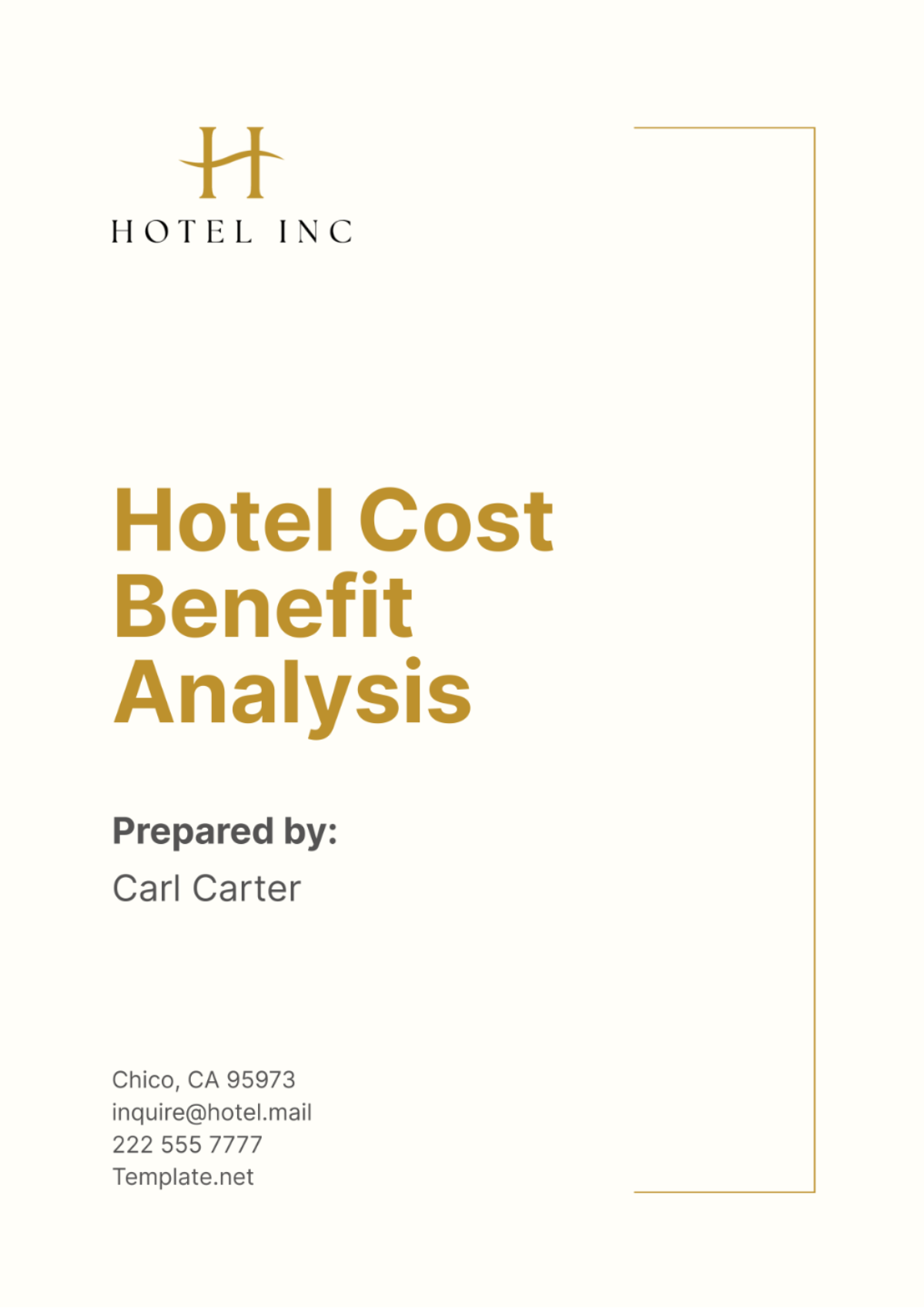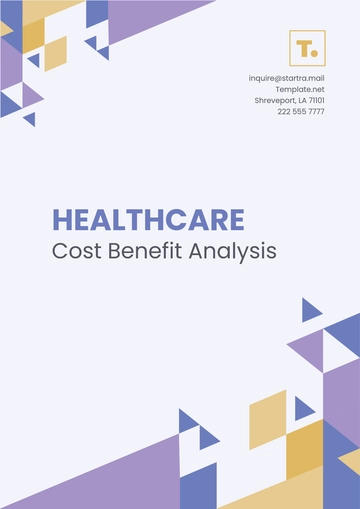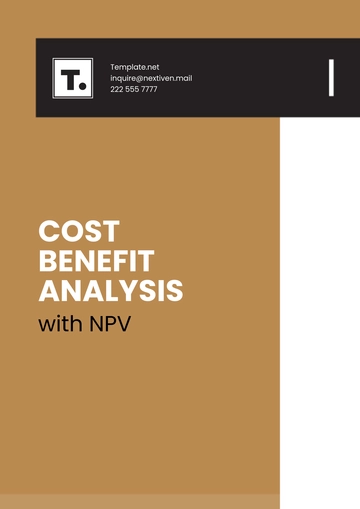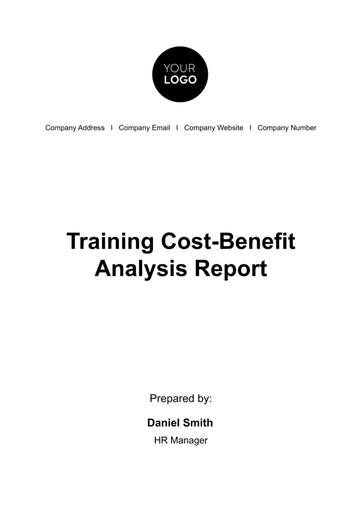Free Hotel Cost Benefit Analysis

I. Introduction
A. Purpose of the Cost Benefit Analysis
The Cost Benefit Analysis (CBA) serves as a critical tool for [Your Company Name] in evaluating the financial viability of its proposed upscale hotel project in downtown Seattle. By systematically examining the anticipated costs and benefits of the investment, this analysis aims to provide decision-makers with actionable insights to guide their strategic planning and resource allocation decisions. Additionally, the CBA will help identify potential risks and opportunities associated with the project, facilitating informed decision-making and maximizing returns on investment.
B. Overview of the Hotel Project
The proposed hotel project seeks to fill a gap in the upscale accommodation market in downtown Seattle, catering to discerning travelers seeking luxury and convenience. With its prime location and sophisticated amenities, including a rooftop bar, spa, and conference facilities, the hotel aims to become a premier destination for both business and leisure travelers alike. [Your Company Name] envisions the hotel as a flagship property that will not only generate substantial revenue but also enhance its brand reputation and contribute to the local economy.
C. Scope and Objectives of the Analysis
The scope of this analysis extends beyond traditional financial metrics to encompass broader considerations such as brand reputation, community impact, and long-term sustainability. In addition to assessing the direct financial costs and benefits of the hotel project, the analysis will explore intangible factors such as increased brand visibility and job creation. The primary objective is to provide stakeholders with a holistic understanding of the potential implications of the investment, enabling them to make well-informed decisions aligned with the organization's strategic objectives.
II. Project Description
A. Description of the Hotel Project
The new hotel will occupy a prime location in downtown Seattle, offering convenient access to major attractions, corporate offices, and transportation hubs. Boasting contemporary architecture and cutting-edge design, the property will feature 200 guest rooms, upscale dining options, and state-of-the-art conference facilities. With its emphasis on luxury, comfort, and personalized service, the hotel aims to set new standards for hospitality excellence in the region.
B. Project Timeline and Milestones
The project will progress through multiple phases, starting with land acquisition and permitting in the first two quarters of [Year]. Construction is slated to commence in the third quarter of [Year] and conclude by the fourth quarter of [Year]. Pre-opening marketing efforts and staff recruitment will take place in the first quarter of [Year], with the grand opening scheduled for the second quarter of [Year]. Each milestone represents a critical step toward realizing the vision for the hotel and achieving operational readiness.
C. Key Stakeholders and Decision Makers
Key stakeholders involved in the project include [Your Company Name], the owner and operator of the hotel, [Company Name A], responsible for project management and construction, and [Company Name B], providing financial advisory services. These stakeholders will collaborate closely throughout the project lifecycle, leveraging their expertise and resources to ensure its successful execution. Additionally, input from local authorities, regulatory bodies, and community stakeholders will be sought to address regulatory compliance and mitigate potential challenges.
III. Cost Analysis
A. Capital Costs
Item | Cost (USD) |
|---|---|
Land Acquisition | $[000] |
Construction | $[000] |
Furniture, Fixtures, & Equipment (FF&E) | $[000] |
Permits & Licenses | $[000] |
B. Operating Costs
Expense | Annual Cost (USD) |
|---|---|
Staff Salaries & Benefits | $[000] |
Utilities | $[000] |
Maintenance & Repairs | $[000] |
Marketing & Advertising | $[000] |
Insurance | $[000] |
Other Operational Expenses | $[000] |
IV. Benefit Analysis
A. Revenue Streams
Revenue Source | Annual Revenue (USD) |
|---|---|
Room Revenue | $[000] |
Food & Beverage Revenue | $[000] |
Conference & Event Revenue | $[000] |
Additional Services Revenue | $[000] |
B. Ancillary Benefits
Increased Brand Visibility and Reputation
The hotel's upscale amenities, alongside its prime location, are strategic components designed to enhance the hotel's brand image and attract a more affluent clientele. This strategy is anticipated to contribute to increasing the hotel's room rates and occupancy levels, ultimately elevating its overall market position and profitability.
Community Development
The development and subsequent management of the hotel are expected to lead to the creation of numerous employment opportunities, provide a significant boost to businesses in the vicinity, and contribute to the generation of substantial tax revenue, all of which will play a crucial role in supporting and enhancing economic development within the local community.
Increased Tourism
By providing high-quality accommodations and superior amenities, the hotel aims to draw visitors both from within the country and from abroad, thereby enhancing Seattle's status as a foremost travel destination and contributing to the growth and vitality of its tourism industry.
V. Assumptions and Methodology
A. Assumptions Underlying Cost Estimates
The cost estimates for land acquisition and construction are based on recent market transactions and bids received from reputable developers and contractors. We have factored in potential cost escalations due to inflation, regulatory changes, and unforeseen site conditions to ensure a realistic assessment of capital expenditures. Additionally, contingency reserves have been allocated to address any unexpected cost overruns or delays during the construction phase. Our approach to estimating operating costs involves benchmarking against industry standards and conducting detailed analyses of historical expenses for similar properties in urban settings. We have accounted for seasonal fluctuations in utility rates, labor costs, and other operating expenses to provide a comprehensive projection of annual operating costs over the hotel's lifecycle.
B. Assumptions Underlying Revenue Projections
Revenue projections are based on a thorough analysis of demand drivers, market trends, and competitive positioning within the upscale hotel segment in downtown Seattle. We have considered factors such as projected occupancy rates, average daily rates (ADR), and revenue per available room (RevPAR) to forecast room revenue accurately. Additionally, revenue projections for food and beverage, conference and event bookings, and other ancillary services are informed by industry benchmarks and historical performance data from similar properties in the market. Sensitivity analysis has been conducted to assess the impact of variations in key assumptions, such as changes in market demand, pricing strategies, and competitive dynamics, on revenue projections.
C. Discount Rate Selection
The discount rate used in the analysis reflects the hotel's cost of capital and incorporates both the cost of debt and the cost of equity. We have considered prevailing market interest rates, risk premiums, and the hotel's specific risk profile to determine an appropriate discount rate. The selected discount rate aligns with industry standards and takes into account factors such as the hotel's location, market positioning, and stage of development. Sensitivity analysis has been performed to evaluate the sensitivity of project outcomes to changes in the discount rate, enabling us to assess the robustness of our valuation under different scenarios.
D. Sensitivity Analysis Parameters
Sensitivity analysis parameters include variations in key variables such as occupancy rates, ADR, construction costs, and discount rates to assess their impact on project outcomes. We have identified critical assumptions and conducted scenario analyses to evaluate the range of potential outcomes and their associated probabilities. Sensitivity analysis results will inform risk management strategies and decision-making processes, allowing stakeholders to understand the degree of uncertainty surrounding the project's financial performance. By incorporating sensitivity analysis into our methodology, we aim to enhance the robustness and reliability of our cost benefit analysis, enabling more informed decision-making and risk mitigation strategies.
VI. Financial Analysis
A. Net Present Value (NPV) Calculation
Using the discounted cash flow (DCF) method, we have calculated the net present value (NPV) of the hotel project by subtracting the present value of all projected cash outflows (capital and operating costs) from the present value of projected cash inflows (revenue streams). Our analysis yielded a positive NPV of $[00] million, indicating that the project is expected to generate value for [Your Company Name]'s stakeholders. This suggests that the investment in the hotel project is economically viable and could potentially generate attractive returns for investors.
B. Internal Rate of Return (IRR) Calculation
The internal rate of return (IRR) for the hotel project represents the discount rate at which the NPV of the project equals zero. By solving for the IRR, we have determined that the project's internal rate of return is [00]%, exceeding the hurdle rate set by [Your Company Name]. This indicates that the hotel project is expected to generate returns that exceed the cost of capital, making it an attractive investment opportunity. The IRR provides a measure of the project's profitability and allows stakeholders to assess its financial feasibility relative to alternative investment opportunities.
C. Payback Period Analysis
The payback period for the hotel project represents the time required for the cumulative cash inflows to equal the initial investment. Our analysis indicates that the hotel project is expected to achieve payback within [00] years, demonstrating the project's ability to recoup its initial investment and start generating positive cash flows. This metric provides insight into the project's liquidity and risk profile, helping stakeholders evaluate the project's financial sustainability and resilience to market fluctuations.
D. Break-Even Analysis
Break-even analysis determines the level of sales or occupancy required for the hotel project to cover its costs and achieve a neutral financial position. Based on our analysis, the break-even occupancy rate for the hotel project is estimated to be [00]%, indicating the minimum level of occupancy required to cover operating expenses and debt service obligations. This analysis provides valuable insights into the project's risk exposure and sensitivity to changes in market conditions, helping stakeholders assess the project's financial viability under different scenarios.
VII. Risk Assessment
A. Identification of Key Risks
Key risks associated with the hotel project include construction delays, cost overruns, fluctuations in market demand, and competitive pressures. Regulatory changes, economic downturns, and unforeseen events such as natural disasters or pandemics could also impact the project's financial performance. By identifying and evaluating these risks, stakeholders can implement proactive risk mitigation strategies to minimize their potential impact on the project's success.
B. Probability and Impact Assessment
We have conducted a comprehensive assessment of the probability and potential impact of each identified risk on the hotel project's financial performance. Risks with high probabilities and significant potential impacts, such as construction delays or adverse market conditions, are prioritized for mitigation efforts. By quantifying the likelihood and severity of each risk, stakeholders can allocate resources effectively and implement targeted risk management strategies to safeguard the project's financial viability.
C. Mitigation Strategies
To mitigate key risks associated with the hotel project, [Your Company Name] will implement a range of risk management strategies, including contingency planning, insurance coverage, and contractual protections. Proactive measures such as diversifying revenue streams, conducting thorough due diligence on contractors and suppliers, and maintaining robust financial reserves will help mitigate the impact of unforeseen events and market fluctuations. Additionally, ongoing monitoring and regular reassessment of risks will allow stakeholders to adapt their mitigation strategies in response to changing market conditions and emerging threats.
VIII. Conclusion
A. Summary of Findings
The Cost Benefit Analysis (CBA) indicates that the proposed hotel project represents a financially sound investment opportunity for [Your Company Name]. With a positive net present value (NPV), attractive internal rate of return (IRR), and favorable payback period, the project is expected to generate significant value for stakeholders over its lifecycle. Despite inherent risks and uncertainties, proactive risk management strategies and prudent financial planning will help mitigate potential challenges and enhance the project's likelihood of success.
B. Recommendation on Project Viability
Based on the analysis conducted, we recommend proceeding with the hotel project, as it offers attractive returns and aligns with [Your Company Name]'s strategic objectives. The project's strong financial performance, coupled with its potential to enhance brand reputation, support economic development, and create value for stakeholders, makes it a compelling investment opportunity. By leveraging the findings of the Cost Benefit Analysis and implementing targeted risk management strategies, [Your Company Name] can position the hotel project for long-term success and sustainable growth.
C. Next Steps and Further Considerations
Moving forward, [Your Company Name] will finalize project financing arrangements, secure necessary permits and approvals, and commence construction activities in accordance with the project timeline. Ongoing monitoring and evaluation will be conducted to track the project's progress, identify emerging risks, and make informed adjustments as needed. Additionally, stakeholder engagement and communication will remain critical throughout the project lifecycle to ensure alignment with key stakeholders and foster transparency and accountability.
- 100% Customizable, free editor
- Access 1 Million+ Templates, photo’s & graphics
- Download or share as a template
- Click and replace photos, graphics, text, backgrounds
- Resize, crop, AI write & more
- Access advanced editor
Introducing Template.net's Hotel Cost Benefit Analysis Template! This editable and customizable template empowers hotel stakeholders to assess financial viability effortlessly. With an intuitive AI Editor Tool, analyze costs, revenue streams, and risks with ease. Optimize decision-making and maximize returns on investment. Elevate your hotel project planning with this comprehensive template from Template.net.





























